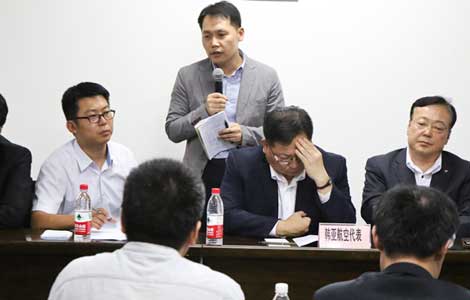
Move aimed at deepening reforms and cutting firms' financing costs
China scrapped the lower limit on bank lending rates on Friday, in a major step toward liberalizing interest rates.
The move is also aimed at cutting financing costs for businesses amid a deepening slowdown in the world's second-largest economy.
It means that China has now ended controls on lending rates.
The People's Bank of China, the central bank, said the lower limit on commercial banks' lending interest rates will be removed from Saturday.
Previously, banks were allowed to extend loans at rates higher than 70 percent of the benchmark lending rate set by the PBOC, which has been held at 6 percent since the last reduction in July 2012.
"Financial institutions will determine the prices for loans by themselves according to commercial principles," the central bank said in a statement on its website.
It also scrapped the upper limit on lending rates among rural credit cooperatives, while leaving a floating range on individual property lending rates untouched to secure "healthy" development of the real estate market.
"After the limits on lending rates are called off ... the negotiating space between financial institutions and clients will be broadened, which will facilitate a decline in enterprises' funding costs as lenders adopt a differentiated pricing strategy," the bank said.
"Therefore, financial resources will be channeled to support the real economy and better serve economic restructuring and upgrading," it said.
Hu Bin, a senior analyst at Moody's, said: "It is a signal that the monetary authority is firmly pushing forward deregulation and will let market forces play a bigger role in allocating financial resources.
"It will be beneficial for the overall economy, but negative for commercial lenders," Hu said.
China has been trying to liberalize interest rates as it promotes reform of the financial system and allows market forces to play a bigger role in determining the price of capital.
In June 2012, it allowed banks' deposit rates to be 10 percent higher than the benchmark rates, while cutting the lower limit on lending rates to 80 percent of the benchmark. In July, it further reduced the limit on lending rates to 70 percent.
But Hu said that given the fact that only a very small proportion of bank loans are priced at 70 percent of benchmark rates, it is hard to say if the new move will result in lower loan prices.
Li Xunlei, chief economist at Shanghai-based Guotai Junan Securities, said 90 percent of bank loans in the first quarter were priced higher than the benchmark rates, and as long as the limits on deposit rates are not touched, it cannot count as a breakthrough in rate liberalization.
Huang Yiping, chief economist, emerging Asia, investment banking division of Barclays Bank, said, "Although the key to interest rate reform still lies in loosening the upper limit on deposit rates, the removal of the lending rate floor might gradually lead to lower financing costs."
Liu Ligang, chief China economist at ANZ Group, said: "China's State-owned enterprises will definitely benefit from the removal of the lending rate floor, as they will have greater bargaining power over banks. The government bond yields will provide a floor for the lending rates."
He said the move could be viewed as a stimulus to the real economy, as State companies will face a lower effective borrowing rate. It would also help the economy pick up somewhat late in the third quarter and in the fourth quarter. "Therefore, a 7.5 percent growth target is more likely to be achieved this year."
The central bank said in a separate statement it has not touched the ceiling on deposit rates because it is the riskiest part of the reform and must be promoted step-by-step.
Cao Yuanzheng, chief economist at the Bank of China, said, "The liquidity crunch in the interbank market in June has shown that banks haven't equipped themselves with mature liquidity management. They are not ready for more substantial deregulation on interest rates."
It is very unlikely that the PBOC will remove the deposit ceiling this year. Instead, some gradual loosening might be introduced, such as allowing banks to develop negotiable certificates of deposit, Hu said.
Sheng Songcheng, head of the central bank's statistics department, said earlier that to free up interest rates, China could raise or even remove the upper limits on banks' deposit rates.
"It could further expand or even remove the officially set floating range of medium- and long-term deposits and then gradually expand the upper limit on short-term and small-sum deposits, until caps on such deposits are abolished."
Analysts have warned that interest-rate liberalization will pose a greater risk to smaller lenders, as they would tend to raise deposit rates in the competition for funds, and prefer to extend riskier loans for higher profits.
Central bank Governor Zhou Xiaochuan said in November that further rate liberalization will come from certain financial institutions. This will be achieved by loosening price restrictions on alternative financial products.








